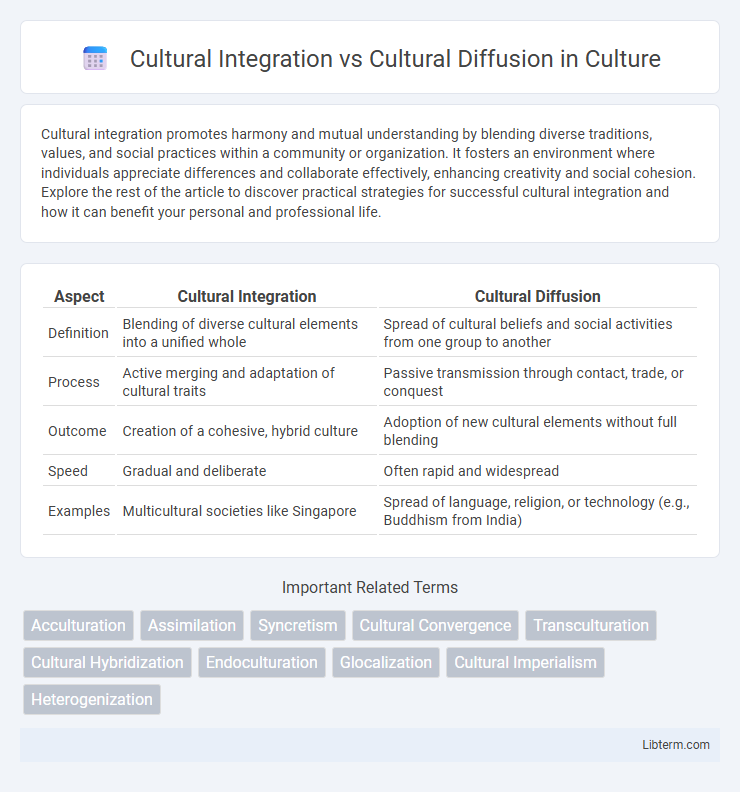Cultural integration promotes harmony and mutual understanding by blending diverse traditions, values, and social practices within a community or organization. It fosters an environment where individuals appreciate differences and collaborate effectively, enhancing creativity and social cohesion. Explore the rest of the article to discover practical strategies for successful cultural integration and how it can benefit your personal and professional life.
Table of Comparison
| Aspect | Cultural Integration | Cultural Diffusion |
|---|---|---|
| Definition | Blending of diverse cultural elements into a unified whole | Spread of cultural beliefs and social activities from one group to another |
| Process | Active merging and adaptation of cultural traits | Passive transmission through contact, trade, or conquest |
| Outcome | Creation of a cohesive, hybrid culture | Adoption of new cultural elements without full blending |
| Speed | Gradual and deliberate | Often rapid and widespread |
| Examples | Multicultural societies like Singapore | Spread of language, religion, or technology (e.g., Buddhism from India) |
Understanding Cultural Integration
Cultural integration refers to the process where diverse cultural groups come together, blending values, customs, and social norms to create a cohesive and harmonious society. It emphasizes mutual respect, adaptation, and the preservation of cultural identities while fostering shared experiences and collaboration. Understanding cultural integration involves recognizing its role in promoting social stability, reducing conflict, and enhancing multicultural coexistence within globalized communities.
Defining Cultural Diffusion
Cultural diffusion is the process by which cultural elements such as beliefs, customs, technologies, and languages spread from one society or group to another, promoting shared cultural traits and innovations. It differs from cultural integration, which involves the blending and harmonizing of diverse cultures within a single social framework, often leading to new hybrid identities. Understanding cultural diffusion highlights how interconnected societies influence each other and contribute to global cultural diversity.
Key Differences Between Integration and Diffusion
Cultural integration involves the blending of different cultural elements into a unified social system, creating shared norms and values within a community. Cultural diffusion refers to the spread of cultural traits from one group to another without necessarily merging them, maintaining distinct cultural identities. Key differences lie in integration fostering cultural cohesion and identity formation, whereas diffusion emphasizes transmission and coexistence of diverse traits without full assimilation.
Historical Examples of Cultural Integration
Historical examples of cultural integration include the Roman Empire's fusion of diverse traditions, languages, and religions, which created a cohesive yet diverse society across Europe, North Africa, and the Middle East. The Mughal Empire in India exemplified cultural integration through the blending of Persian, Indian, and Islamic art, architecture, and administration, influencing the subcontinent's culture profoundly. In contrast to cultural diffusion, which spreads cultural traits between groups, cultural integration involves the merging of distinct cultural elements into a unified social framework.
Major Instances of Cultural Diffusion
Major instances of cultural diffusion include the Silk Road's facilitation of trade and cultural exchange between Asia, the Middle East, and Europe, spreading goods, ideas, and technologies. The Columbian Exchange dramatically transferred crops, animals, and cultural practices between the Americas and the Old World, reshaping global societies. The spread of Islam through trade routes and conquests introduced religious beliefs, languages, and cultural customs across North Africa, the Middle East, and parts of Asia.
Factors Influencing Cultural Integration
Factors influencing cultural integration include social interaction, shared values, and economic interdependence that facilitate the blending of distinct cultural practices into a cohesive society. Migration patterns and policies promoting multiculturalism often accelerate integration by encouraging acceptance and adaptation among diverse groups. Language proficiency and education systems also play crucial roles in bridging cultural gaps, enabling communication and mutual understanding essential for successful integration.
Drivers Behind Cultural Diffusion
Cultural diffusion is driven by factors such as trade, migration, communication technologies, and globalization, which facilitate the spread of ideas, customs, and innovations across different societies. These drivers enable intercultural exchanges that reshape social practices and beliefs beyond original cultural boundaries. Unlike cultural integration, which involves blending distinct cultures into a cohesive whole, cultural diffusion primarily emphasizes the transmission and adaptation of cultural traits between groups.
Effects on Society and Identity
Cultural integration fosters social cohesion by blending diverse cultural practices into a unified identity, enhancing mutual understanding and shared values within a community. Cultural diffusion spreads ideas, customs, and technologies across societies, promoting innovation but sometimes causing cultural homogenization or loss of traditional identities. The balance between integration and diffusion affects social stability, identity preservation, and the adaptability of cultures in a globalized world.
Challenges in Managing Cultural Interactions
Challenges in managing cultural interactions arise from the complexities of cultural integration and cultural diffusion, where integration demands harmonious blending of diverse cultural identities within a community, often facing resistance due to deep-rooted traditions and social norms. Cultural diffusion involves the spreading of cultural elements across different societies, posing difficulties in preserving original cultural values while adapting to new influences. Balancing respect for cultural uniqueness against the need for social cohesion requires strategic communication, sensitivity, and inclusive policies to mitigate misunderstandings and conflicts.
Future Trends in Global Culture
Future trends in global culture reveal increasing cultural integration driven by digital connectivity, where shared values and hybrid identities emerge across borders. Cultural diffusion continues to spread unique traditions and innovations through global migration and media platforms, enhancing multicultural exchanges and creativity. Advanced technologies like AI and virtual reality will further accelerate the blending and transmission of cultural elements, shaping a more interconnected yet diverse global society.
Cultural Integration Infographic

 libterm.com
libterm.com